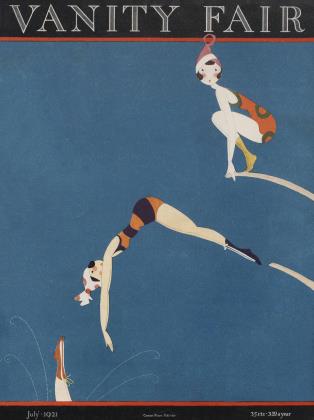Sign In to Your Account
Subscribers have complete access to the archive.
Sign In Not a Subscriber?Join NowBabson on Broadway
KENNETH MACGOWAN
Vanity Fair's Industrial Statisticians Report on the Present State of the Art of the Theatre
WHEN next you drop in on the president of your bank don't waste your time discussing the fourth hole at Palm Beach or the hors d'oeuvres at the Ritz. Observe, instead, the chart on the wall. You may have always imagined it was a Japanese print of Fugiyama; but put on your glasses and you will detect that it demonstrates the rise and decline of the high cost of living. Note, also, the diagram under the glass of his desk showing the organization • of the safe deposit personnel. If you will look sharply, you will discover at his right hand a bulky loose-leaf file of statistics, graphs, charts and diagrams hall-marked at some point or other with the name of Roger Babson, the sage of Wellesley. Babsonism is in the air.
As nearly as I can define it, it is the demonstration by means of charts that the index number of fifty selected serials, which nobody eats, is lower than the unit value (or something of that sort) of wages in the nutmeg industry.
Why not extend Babsonism to Broadway? Dramatic criticism is, after all, too inexact a science. The reviewer should give way to the industrial statistician.
A portion of the work of our statistician must, of course, be destructive. He should begin on the critics. He should give us comparisons between the number of plays hailed as "successes by the critics and the actual number recorded at the box office. Next he could give us the total number of times the word "hit" is used each season in the reviews of notoriously unpopular musical shows compared with the number of times the same word appears in the baseball columns. He might discover whether or not the explanations of what Barrie meant in "Mary Rose" would, if placed end to end, reach from Park Row to Matteawan. There are other such problems as:
For the soberer student of the drama, a chart showing the rise and fall of Ibsen's influence on the American stage as indicated by the topics of discussion in the drama sections of the women's clubs of America.
For the more frivolous, a chart showing the comparative number of phonograph records of "The Love Nest" and the "Liebestod" sold during 1920.
American Small-town Comedies
Small-town Comedies with dress suit finish Dramas by Augustus Thomas
Dramas by Thomas on mental science
a Number of Actors in U. S.
Number of Actors prepared to play Hamlet Number of Actors capable of playing Hamlet
LECTURES 80%
READING 17%
PLAYGOING 3%
DINNERS WITH ACTORS
DINNERS WITH ACTRESSES
LOSSES ON PAST FAILURES
CORONA CORONAS
PRIVATE STOCK
PRESS AGENT
ADVANCES TO PLAYWRIGHTS
BICYCLE GIRL JOKES 1895-1900
SUFFRAGETTE JOKES 1910-1914
COOTIE JOKES 1914-1918
PROHIBITION JOKES 1918-1921
EINSTEIN JOKES 1918-1921
 View Full Issue
View Full Issue






Subscribers have complete access to the archive.
Sign In Not a Subscriber?Join Now